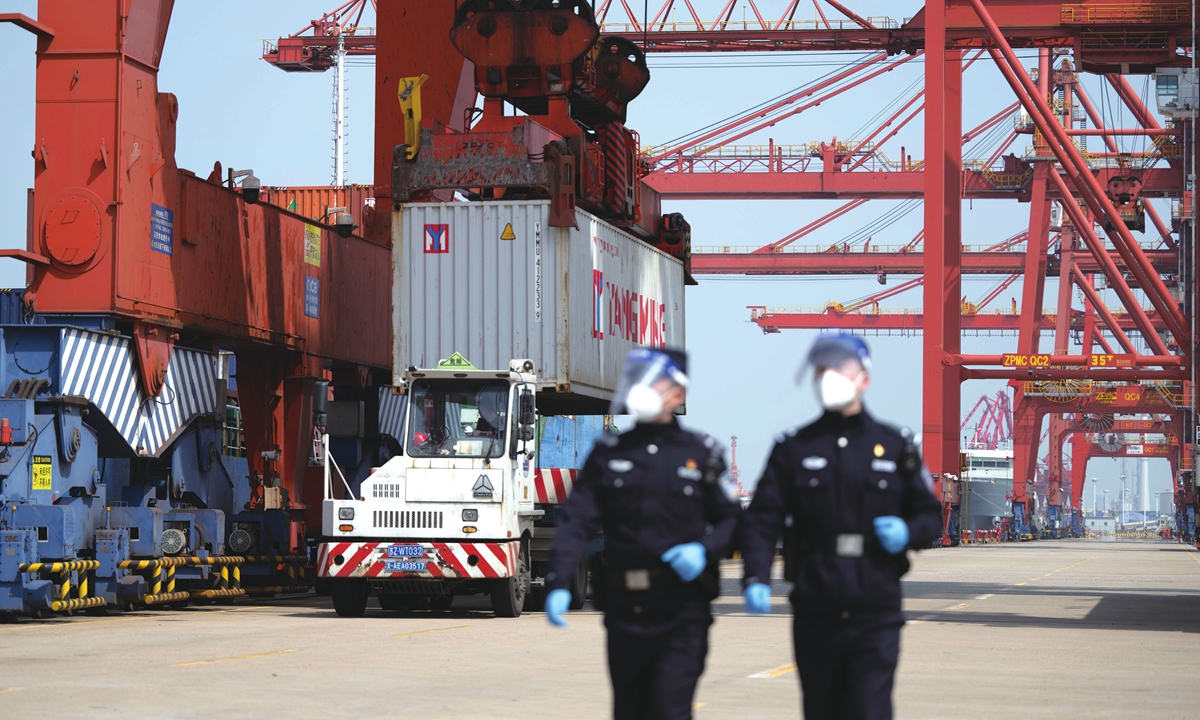
Police are on patrol at the Zhangjiagang port in East China's Jiangsu Province on March 29, 2022. As China continues to face COVID-19 outbreaks, authorities in various places such as Jiangsu are moving to stabilize trade. Photo: cnsphoto
China's trade with Russia saw significantly slower growth in the first quarter of 2022, due to a combination of factors ranging from a high base in the previous year to disruptions to logistics and trade settlements amid the Russia-Ukraine conflict and US-led Western economic sanctions against Russia, according to Chinese customs data on Wednesday.
Still, China-Russia trade maintained relatively high-speed growth during the quarter, in comparison to growth paces in China's trade with some major trading partners, including the US. And experts stressed that China-Russia trade could still surpass 1 trillion yuan ($157 billion) this year, as both sides aim to expand bilateral economic and trade cooperation in line with their close diplomatic ties.
According to data released by China's General Administration of Customs on Wednesday, China-Russia trade stood at $38.2 billion in the first three months, up 28.7 percent on a yearly basis. The growth rate dropped from 38.5 percent in the first two months in 2022.
Chinese customs spokesperson Li Kuiwen also said at a press conference on Wednesday that China-Ukraine trade stood at about 29.59 billion yuan in the first quarter, achieving positive growth.
"Chinese customs will continue to serve China's normal trade cooperation with countries including Russia and Ukraine," he said.
The slowdown in China's trade with Russia was more evident in the export sector than in the import sector. In the first quarter, China's exports to Russia increased 25.9 percent year-on-year, down from 41.5 percent in the first two months. Import growth fell from 35.8 percent in the first two months to 31 percent in the first quarter.
A mixture of factors was behind the slowdown, including the fallout from the Russia-Ukraine conflict and the ensuing Western sanctions against Russia, which made shipments and trade settlement inconvenient, analysts noted.
"Local currency settlement usually accounts for less than one-fourth of China-Russia trade payments. If US dollar payments are cut off by Western sanctions, companies in Russia and China have to search for new trade settlement methods, and this takes some time," Li Ziguo, a senior research fellow with the China Institute of International Studies, told the Global Times on Wednesday.
Logistics was another problem, as many international shipment companies halted services for Russia, and there was a lack of containers to ship Russian goods out, Li said, noting that the impact of these logistics bottlenecks would linger for some time.
A report by rzd-partner.ru said that the delivery time for goods moving between China and Russia by rail has risen from 10-14 days to 21 days recently.
Chen Jia, a research fellow with the International Monetary Institute of the Renmin University of China, said that China-Russia trade is going through some structural adjustment after years of rapid growth, such as expanding from energy and raw material imports to other products like grain, while the ways to pay for imports in yuan are increasing.
Such factors, along with a high base effect, will mean volatility in China-Russia trade in the short term, Chen said.
But experts said that China-Russia trade growth is still higher than China's bilateral trade growth with most regions, which underscores that the two countries' trade sectors have maintained relatively high-speed growth despite a slowdown.
In dollar terms, the 28.7-percent growth in China's trade with Russia was significantly faster than the 12.2-percent growth in China's trade with the US during the same period.
"China-Russia trade will show a relatively large increase despite the Ukraine crisis and COVID-19 outbreaks, because the two countries' trade complementarity and trade relations will develop further as Russia needs to strengthen cooperation with China to recoup capital, whether in terms of the yuan or the ruble, while China needs Russian commodities like energy, mining products and food," Song Kui, president of the Contemporary China-Russia Regional Economy Research Institute, told the Global Times on Wednesday.
Song predicted that China-Russia trade will maintain robust growth this year and surge above 1 trillion yuan. China-Russia trade stood at $147 billion, a record high, in 2021.
Li said it's very likely that bilateral trade growth in 2022 will be lower than last year, but the decline will not be huge as the countries' products fit each other's needs.




